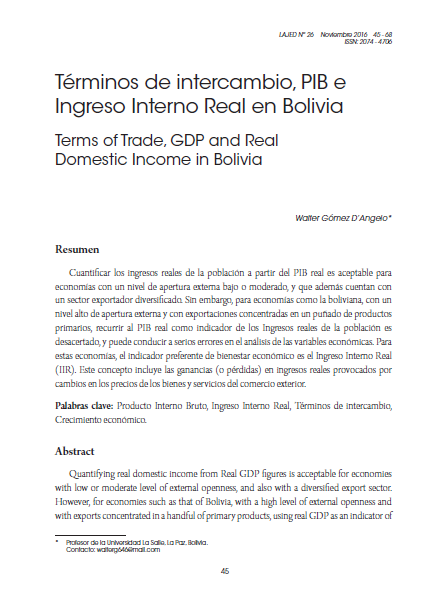Terms of Trade, GDP and Real Domestic Income in Bolivia
DOI:
https://doi.org/10.35319/lajed.20162657Keywords:
Gross Domestic Product, Gross Domestic Income, Terms of Trade, Economic GrowthAbstract
Quantifying real domestic income from Real GDP figures is acceptable for economies with low or moderate level of external openness, and also with a diversified export sector. However, for economies such as that of Bolivia, with a high level of external openness and with exports concentrated in a handful of primary products, using real GDP as an indicator of real domestic income is ill-advised, and may lead to serious errors in the analysis of economic variables. For these economies, the preferred indicator of domestic income and economic well-being is Real Gross Domestic Income (Real GDI). This concept (Real GDI) includes real income gains (or losses) brought out by changes in foreign trade prices.
Downloads
References
Banco Mundial. Banco de datos. http://databank.worldbank.org/data/
Blades, Derek. 1989. “Revision of the System of National Accounts: A note on Objectives and Key Issues”. OECD Journal of Economic Studies,12, 205-219.
Blanchard, Oliver J. y Stanley Fischer. 1989. Lectures on Macroeconomics. Cambridge, MA. MIT Press.
Blanchard, Oliver. 2009. Macroeconomics, Fifth Edition. New Jersey. Prentice Hall
Clement, M.O., Richard I. Pfister y Kenneth J. Rothwell. 1967. Theoretical Issues in International Economics, Markham, Jesse W. Editor. Bon.
Dornbusch, Rudiger, Stanley Fischer y Richard Startz. 2008. Macroeconomía, décima edición, New York: McGraw Hill. 7. Courbis, R.W. 1969. “Comptabilité nationale à prix constants et à productivité constante”. The Review of Income and Wealth, 15(1), 33-76.
Gómez D’ Angelo, Walter. 2013. “¿A quién beneficia la acumulación de reservas internacionales en Bolivia?”, Perspectivas, 16(31), 157-173, Universidad Católica, Cochabamba, Bolivia.
Gutmann, Pierre. 1981. “The Measurement of Terms of Trade Effects, OECD”. The Review of Income and Wealth, 27(4), 433-453.
INE. Bolivia. Base de datos. http://www.ine.gob.bo/
Kohli, Ulrich. 2004. “Real GDP. Real domestic income, and terms-of-trade changes”. Journal of International Economics, 62, 83-106.
Krugman, Paul y Robin Wells. 2006. Macroeconomics, New York: Worth Publishers.
Kurabayashi, Y. 1971. “The impact of change in the terms of trade on a system of national accounts”. The Review of Income and Wealth, 17(3), 285-297.
Mankiw, N. Gregory. 2006. Macroeconomía, sexta edición. España.
Morales, J.A. (ed.), E. Aranibar, J.C. Jemio, M. Medinaceli, G. Molina, M. Ríos-García y C. Schlink. 2014. ¿Dónde está la plata? Los ingresos extraordinarios de la bonanza 2006- 2013. Fundación Konrad Adenauer, La Paz. 63 Walter Gómez D’Angelo
Nicholson, J. L. 1960. "The effects of international trade on the measurement of real national income". The Economic Journal, 70 (279), 608-612.
Sachs, Jeffrey D. y Felipe B. Larraín. 1992. Macroeconomics in the Global Economy. Prentice Hall.
Reinsdorf, Marshall B. 2009. Terms of Trade Effects: Theory and Measurement. Bureau of Economic Analysis, EEUU.
---------- Measuring the Effects of Terms of Trade in National Accounts. Workshop presentation at the University of Pennsylvania, May 11, 2008.
United Nations. System of National Accounts. 2008. http://unstats.un.org/unsd/nationalaccount/docs/SNA2008.pdf






